Business Intelligence Report: Data Mining, AI, and Weka Analysis
VerifiedAdded on 2021/06/18
|20
|3036
|86
Report
AI Summary
This report delves into the realm of business intelligence, commencing with a comprehensive definition of text mining and text analytics, highlighting their role in extracting valuable insights from unstructured data. It then differentiates text mining from data mining, elucidating their distinct methodologies and applications. The report further explores the application of Artificial Intelligence (AI) in business transformation, emphasizing its capacity to automate tasks, enhance existing systems, and drive data-driven decision-making. A significant portion of the report is dedicated to data analysis, utilizing the Weka data mining tool and the J48 algorithm to analyze bank data, including attributes like income, savings, current accounts, mortgage, and sex. The analysis provides detailed insights into these attributes, supported by the J48 algorithm's classification results, confusion matrices, and accuracy metrics. Finally, the report touches upon the importance of dashboards in visualizing and interpreting the analyzed data, providing a holistic overview of business intelligence concepts and techniques. The report provides a detailed overview of the data analysis process, including data pre-processing, model selection, and evaluation, with specific attention to the J48 decision tree algorithm and its application to the bank data.

Business Intelligence
Paraphrase This Document
Need a fresh take? Get an instant paraphrase of this document with our AI Paraphraser
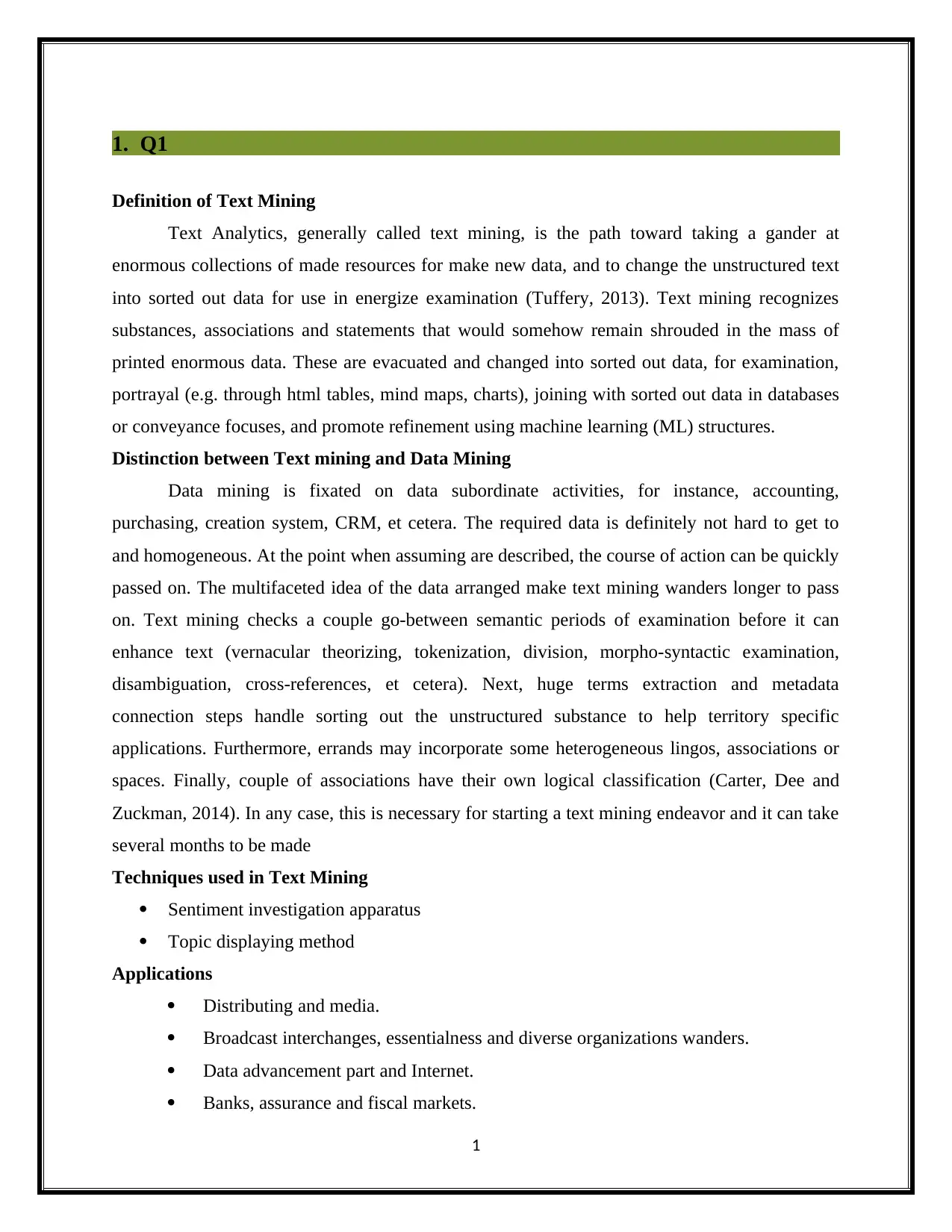
1. Q1
Definition of Text Mining
Text Analytics, generally called text mining, is the path toward taking a gander at
enormous collections of made resources for make new data, and to change the unstructured text
into sorted out data for use in energize examination (Tuffery, 2013). Text mining recognizes
substances, associations and statements that would somehow remain shrouded in the mass of
printed enormous data. These are evacuated and changed into sorted out data, for examination,
portrayal (e.g. through html tables, mind maps, charts), joining with sorted out data in databases
or conveyance focuses, and promote refinement using machine learning (ML) structures.
Distinction between Text mining and Data Mining
Data mining is fixated on data subordinate activities, for instance, accounting,
purchasing, creation system, CRM, et cetera. The required data is definitely not hard to get to
and homogeneous. At the point when assuming are described, the course of action can be quickly
passed on. The multifaceted idea of the data arranged make text mining wanders longer to pass
on. Text mining checks a couple go-between semantic periods of examination before it can
enhance text (vernacular theorizing, tokenization, division, morpho-syntactic examination,
disambiguation, cross-references, et cetera). Next, huge terms extraction and metadata
connection steps handle sorting out the unstructured substance to help territory specific
applications. Furthermore, errands may incorporate some heterogeneous lingos, associations or
spaces. Finally, couple of associations have their own logical classification (Carter, Dee and
Zuckman, 2014). In any case, this is necessary for starting a text mining endeavor and it can take
several months to be made
Techniques used in Text Mining
Sentiment investigation apparatus
Topic displaying method
Applications
Distributing and media.
Broadcast interchanges, essentialness and diverse organizations wanders.
Data advancement part and Internet.
Banks, assurance and fiscal markets.
1
Definition of Text Mining
Text Analytics, generally called text mining, is the path toward taking a gander at
enormous collections of made resources for make new data, and to change the unstructured text
into sorted out data for use in energize examination (Tuffery, 2013). Text mining recognizes
substances, associations and statements that would somehow remain shrouded in the mass of
printed enormous data. These are evacuated and changed into sorted out data, for examination,
portrayal (e.g. through html tables, mind maps, charts), joining with sorted out data in databases
or conveyance focuses, and promote refinement using machine learning (ML) structures.
Distinction between Text mining and Data Mining
Data mining is fixated on data subordinate activities, for instance, accounting,
purchasing, creation system, CRM, et cetera. The required data is definitely not hard to get to
and homogeneous. At the point when assuming are described, the course of action can be quickly
passed on. The multifaceted idea of the data arranged make text mining wanders longer to pass
on. Text mining checks a couple go-between semantic periods of examination before it can
enhance text (vernacular theorizing, tokenization, division, morpho-syntactic examination,
disambiguation, cross-references, et cetera). Next, huge terms extraction and metadata
connection steps handle sorting out the unstructured substance to help territory specific
applications. Furthermore, errands may incorporate some heterogeneous lingos, associations or
spaces. Finally, couple of associations have their own logical classification (Carter, Dee and
Zuckman, 2014). In any case, this is necessary for starting a text mining endeavor and it can take
several months to be made
Techniques used in Text Mining
Sentiment investigation apparatus
Topic displaying method
Applications
Distributing and media.
Broadcast interchanges, essentialness and diverse organizations wanders.
Data advancement part and Internet.
Banks, assurance and fiscal markets.
1
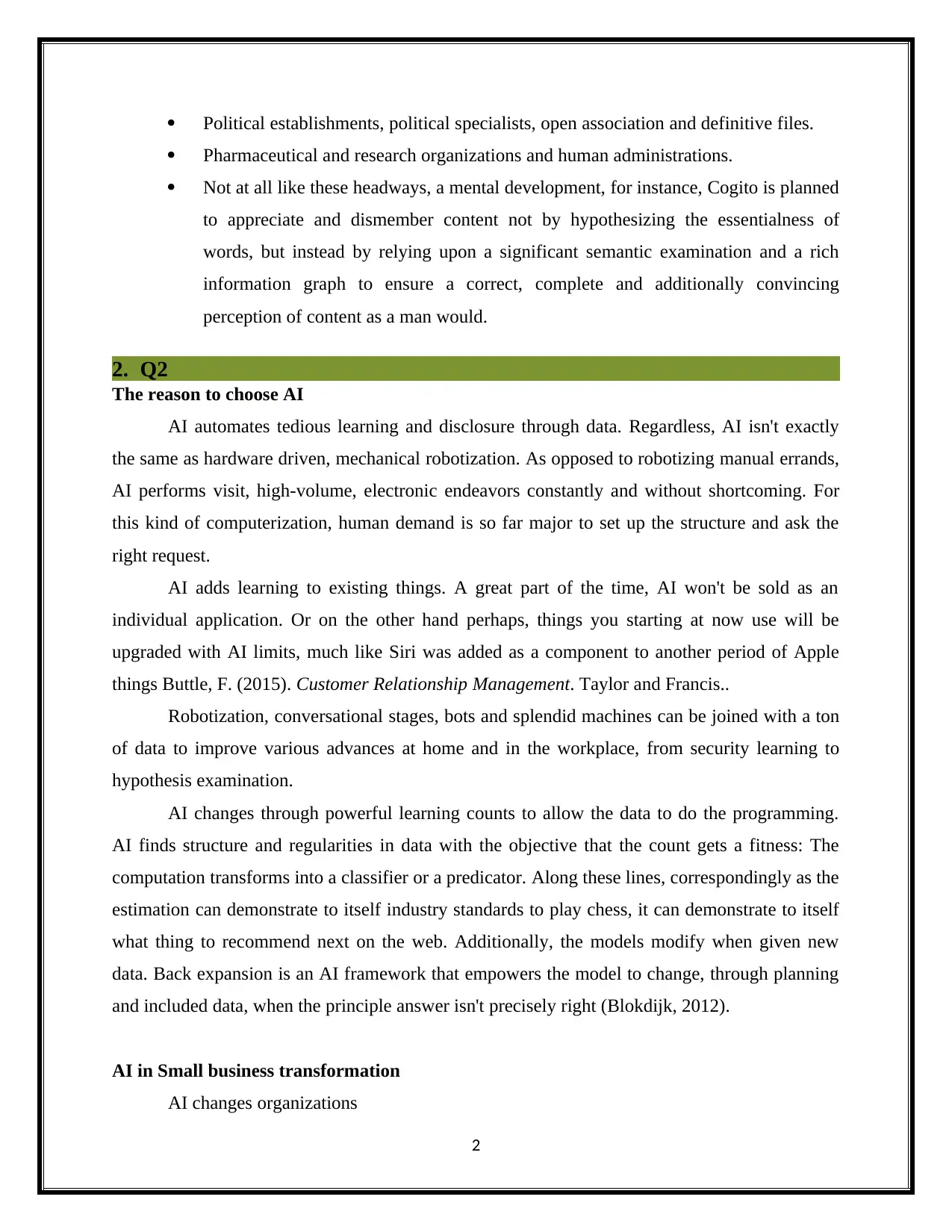
Political establishments, political specialists, open association and definitive files.
Pharmaceutical and research organizations and human administrations.
Not at all like these headways, a mental development, for instance, Cogito is planned
to appreciate and dismember content not by hypothesizing the essentialness of
words, but instead by relying upon a significant semantic examination and a rich
information graph to ensure a correct, complete and additionally convincing
perception of content as a man would.
2. Q2
The reason to choose AI
AI automates tedious learning and disclosure through data. Regardless, AI isn't exactly
the same as hardware driven, mechanical robotization. As opposed to robotizing manual errands,
AI performs visit, high-volume, electronic endeavors constantly and without shortcoming. For
this kind of computerization, human demand is so far major to set up the structure and ask the
right request.
AI adds learning to existing things. A great part of the time, AI won't be sold as an
individual application. Or on the other hand perhaps, things you starting at now use will be
upgraded with AI limits, much like Siri was added as a component to another period of Apple
things Buttle, F. (2015). Customer Relationship Management. Taylor and Francis..
Robotization, conversational stages, bots and splendid machines can be joined with a ton
of data to improve various advances at home and in the workplace, from security learning to
hypothesis examination.
AI changes through powerful learning counts to allow the data to do the programming.
AI finds structure and regularities in data with the objective that the count gets a fitness: The
computation transforms into a classifier or a predicator. Along these lines, correspondingly as the
estimation can demonstrate to itself industry standards to play chess, it can demonstrate to itself
what thing to recommend next on the web. Additionally, the models modify when given new
data. Back expansion is an AI framework that empowers the model to change, through planning
and included data, when the principle answer isn't precisely right (Blokdijk, 2012).
AI in Small business transformation
AI changes organizations
2
Pharmaceutical and research organizations and human administrations.
Not at all like these headways, a mental development, for instance, Cogito is planned
to appreciate and dismember content not by hypothesizing the essentialness of
words, but instead by relying upon a significant semantic examination and a rich
information graph to ensure a correct, complete and additionally convincing
perception of content as a man would.
2. Q2
The reason to choose AI
AI automates tedious learning and disclosure through data. Regardless, AI isn't exactly
the same as hardware driven, mechanical robotization. As opposed to robotizing manual errands,
AI performs visit, high-volume, electronic endeavors constantly and without shortcoming. For
this kind of computerization, human demand is so far major to set up the structure and ask the
right request.
AI adds learning to existing things. A great part of the time, AI won't be sold as an
individual application. Or on the other hand perhaps, things you starting at now use will be
upgraded with AI limits, much like Siri was added as a component to another period of Apple
things Buttle, F. (2015). Customer Relationship Management. Taylor and Francis..
Robotization, conversational stages, bots and splendid machines can be joined with a ton
of data to improve various advances at home and in the workplace, from security learning to
hypothesis examination.
AI changes through powerful learning counts to allow the data to do the programming.
AI finds structure and regularities in data with the objective that the count gets a fitness: The
computation transforms into a classifier or a predicator. Along these lines, correspondingly as the
estimation can demonstrate to itself industry standards to play chess, it can demonstrate to itself
what thing to recommend next on the web. Additionally, the models modify when given new
data. Back expansion is an AI framework that empowers the model to change, through planning
and included data, when the principle answer isn't precisely right (Blokdijk, 2012).
AI in Small business transformation
AI changes organizations
2
⊘ This is a preview!⊘
Do you want full access?
Subscribe today to unlock all pages.

Trusted by 1+ million students worldwide
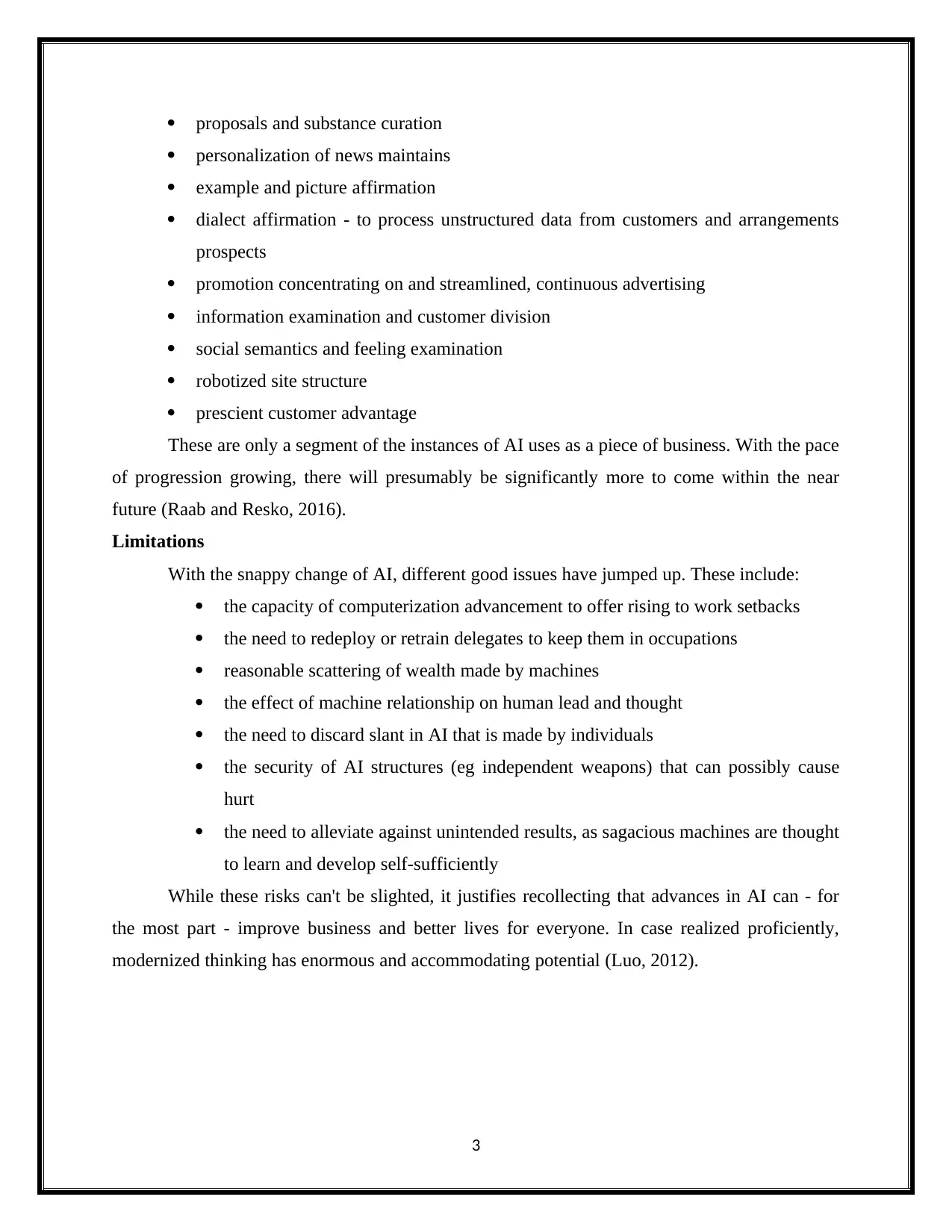
proposals and substance curation
personalization of news maintains
example and picture affirmation
dialect affirmation - to process unstructured data from customers and arrangements
prospects
promotion concentrating on and streamlined, continuous advertising
information examination and customer division
social semantics and feeling examination
robotized site structure
prescient customer advantage
These are only a segment of the instances of AI uses as a piece of business. With the pace
of progression growing, there will presumably be significantly more to come within the near
future (Raab and Resko, 2016).
Limitations
With the snappy change of AI, different good issues have jumped up. These include:
the capacity of computerization advancement to offer rising to work setbacks
the need to redeploy or retrain delegates to keep them in occupations
reasonable scattering of wealth made by machines
the effect of machine relationship on human lead and thought
the need to discard slant in AI that is made by individuals
the security of AI structures (eg independent weapons) that can possibly cause
hurt
the need to alleviate against unintended results, as sagacious machines are thought
to learn and develop self-sufficiently
While these risks can't be slighted, it justifies recollecting that advances in AI can - for
the most part - improve business and better lives for everyone. In case realized proficiently,
modernized thinking has enormous and accommodating potential (Luo, 2012).
3
personalization of news maintains
example and picture affirmation
dialect affirmation - to process unstructured data from customers and arrangements
prospects
promotion concentrating on and streamlined, continuous advertising
information examination and customer division
social semantics and feeling examination
robotized site structure
prescient customer advantage
These are only a segment of the instances of AI uses as a piece of business. With the pace
of progression growing, there will presumably be significantly more to come within the near
future (Raab and Resko, 2016).
Limitations
With the snappy change of AI, different good issues have jumped up. These include:
the capacity of computerization advancement to offer rising to work setbacks
the need to redeploy or retrain delegates to keep them in occupations
reasonable scattering of wealth made by machines
the effect of machine relationship on human lead and thought
the need to discard slant in AI that is made by individuals
the security of AI structures (eg independent weapons) that can possibly cause
hurt
the need to alleviate against unintended results, as sagacious machines are thought
to learn and develop self-sufficiently
While these risks can't be slighted, it justifies recollecting that advances in AI can - for
the most part - improve business and better lives for everyone. In case realized proficiently,
modernized thinking has enormous and accommodating potential (Luo, 2012).
3
Paraphrase This Document
Need a fresh take? Get an instant paraphrase of this document with our AI Paraphraser
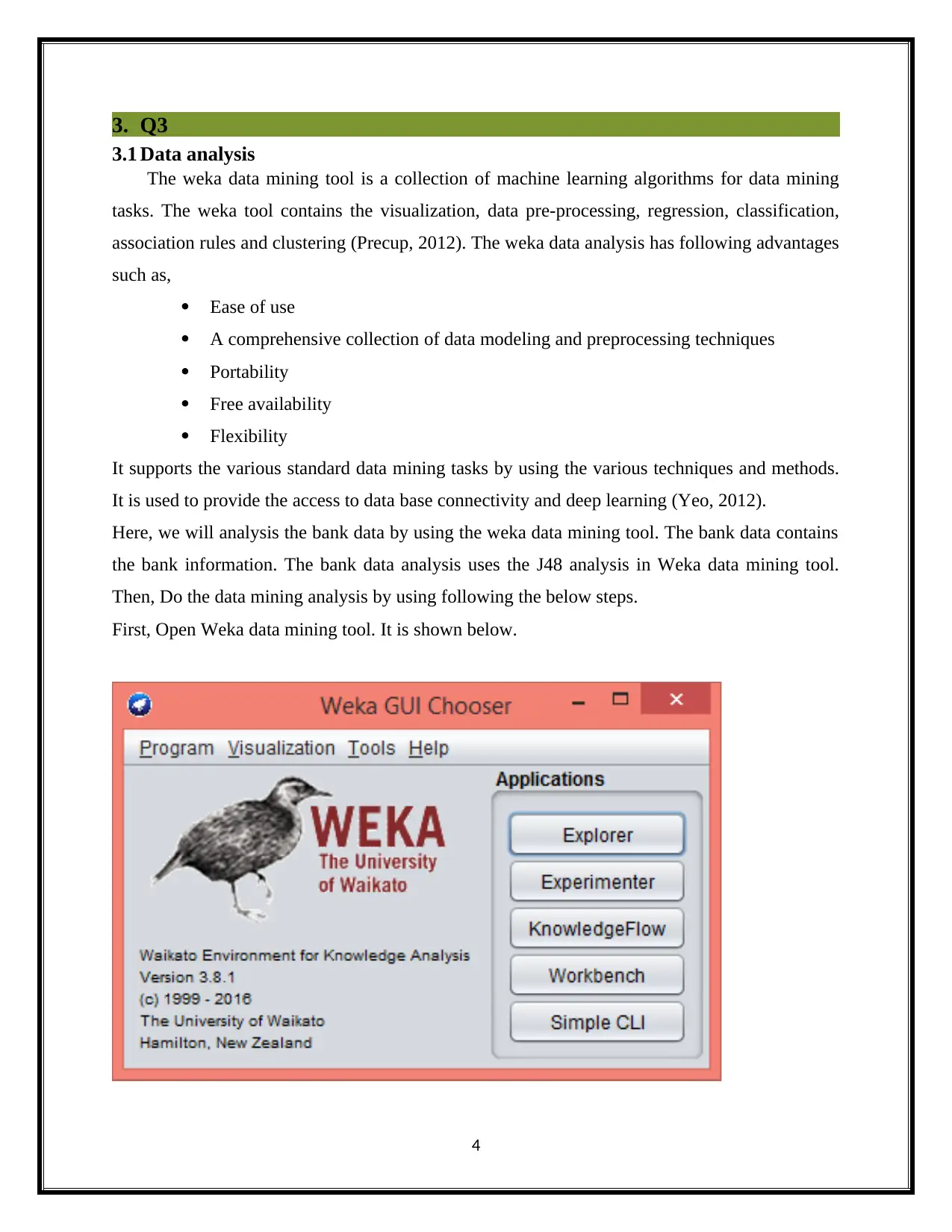
3. Q3
3.1 Data analysis
The weka data mining tool is a collection of machine learning algorithms for data mining
tasks. The weka tool contains the visualization, data pre-processing, regression, classification,
association rules and clustering (Precup, 2012). The weka data analysis has following advantages
such as,
Ease of use
A comprehensive collection of data modeling and preprocessing techniques
Portability
Free availability
Flexibility
It supports the various standard data mining tasks by using the various techniques and methods.
It is used to provide the access to data base connectivity and deep learning (Yeo, 2012).
Here, we will analysis the bank data by using the weka data mining tool. The bank data contains
the bank information. The bank data analysis uses the J48 analysis in Weka data mining tool.
Then, Do the data mining analysis by using following the below steps.
First, Open Weka data mining tool. It is shown below.
4
3.1 Data analysis
The weka data mining tool is a collection of machine learning algorithms for data mining
tasks. The weka tool contains the visualization, data pre-processing, regression, classification,
association rules and clustering (Precup, 2012). The weka data analysis has following advantages
such as,
Ease of use
A comprehensive collection of data modeling and preprocessing techniques
Portability
Free availability
Flexibility
It supports the various standard data mining tasks by using the various techniques and methods.
It is used to provide the access to data base connectivity and deep learning (Yeo, 2012).
Here, we will analysis the bank data by using the weka data mining tool. The bank data contains
the bank information. The bank data analysis uses the J48 analysis in Weka data mining tool.
Then, Do the data mining analysis by using following the below steps.
First, Open Weka data mining tool. It is shown below.
4
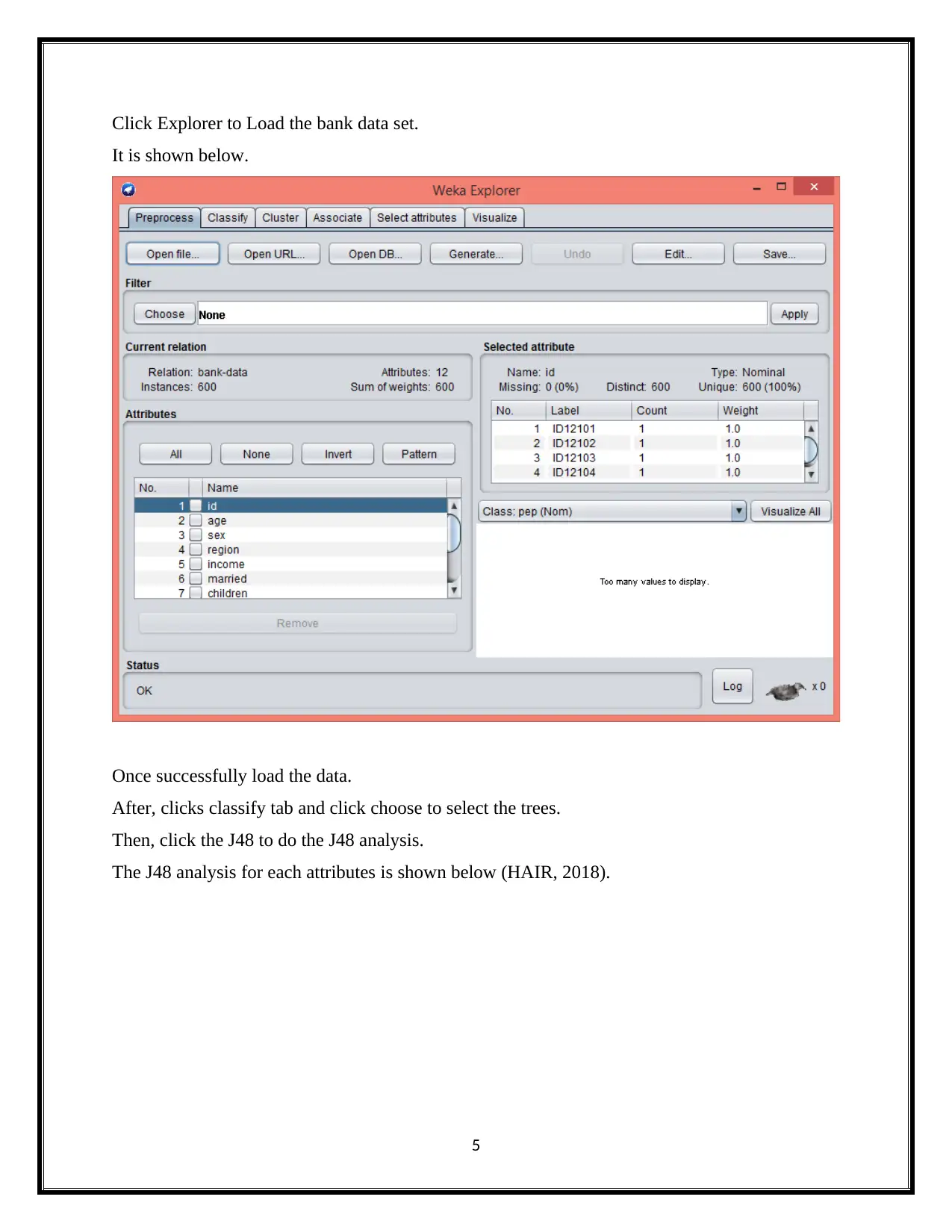
Click Explorer to Load the bank data set.
It is shown below.
Once successfully load the data.
After, clicks classify tab and click choose to select the trees.
Then, click the J48 to do the J48 analysis.
The J48 analysis for each attributes is shown below (HAIR, 2018).
5
It is shown below.
Once successfully load the data.
After, clicks classify tab and click choose to select the trees.
Then, click the J48 to do the J48 analysis.
The J48 analysis for each attributes is shown below (HAIR, 2018).
5
⊘ This is a preview!⊘
Do you want full access?
Subscribe today to unlock all pages.

Trusted by 1+ million students worldwide
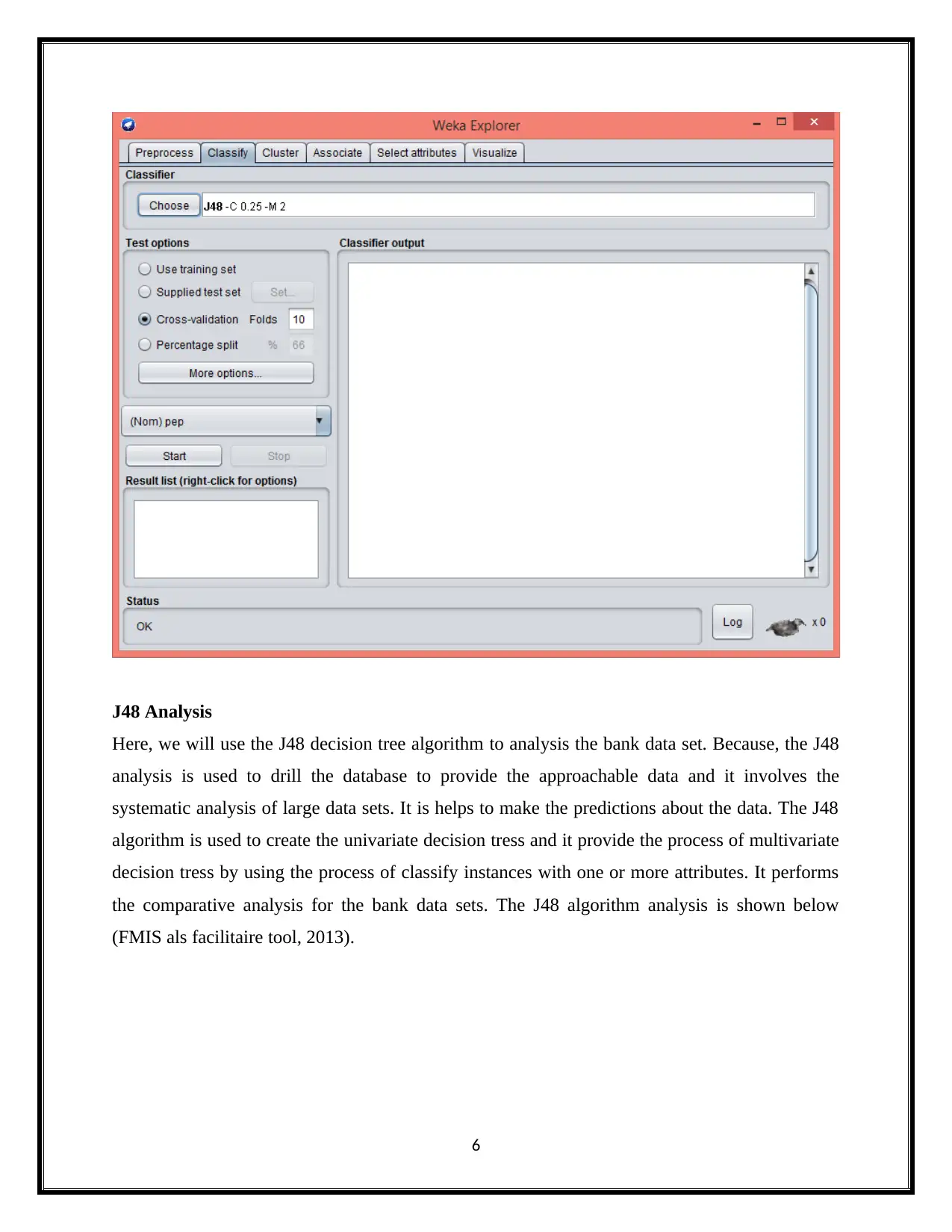
J48 Analysis
Here, we will use the J48 decision tree algorithm to analysis the bank data set. Because, the J48
analysis is used to drill the database to provide the approachable data and it involves the
systematic analysis of large data sets. It is helps to make the predictions about the data. The J48
algorithm is used to create the univariate decision tress and it provide the process of multivariate
decision tress by using the process of classify instances with one or more attributes. It performs
the comparative analysis for the bank data sets. The J48 algorithm analysis is shown below
(FMIS als facilitaire tool, 2013).
6
Here, we will use the J48 decision tree algorithm to analysis the bank data set. Because, the J48
analysis is used to drill the database to provide the approachable data and it involves the
systematic analysis of large data sets. It is helps to make the predictions about the data. The J48
algorithm is used to create the univariate decision tress and it provide the process of multivariate
decision tress by using the process of classify instances with one or more attributes. It performs
the comparative analysis for the bank data sets. The J48 algorithm analysis is shown below
(FMIS als facilitaire tool, 2013).
6
Paraphrase This Document
Need a fresh take? Get an instant paraphrase of this document with our AI Paraphraser
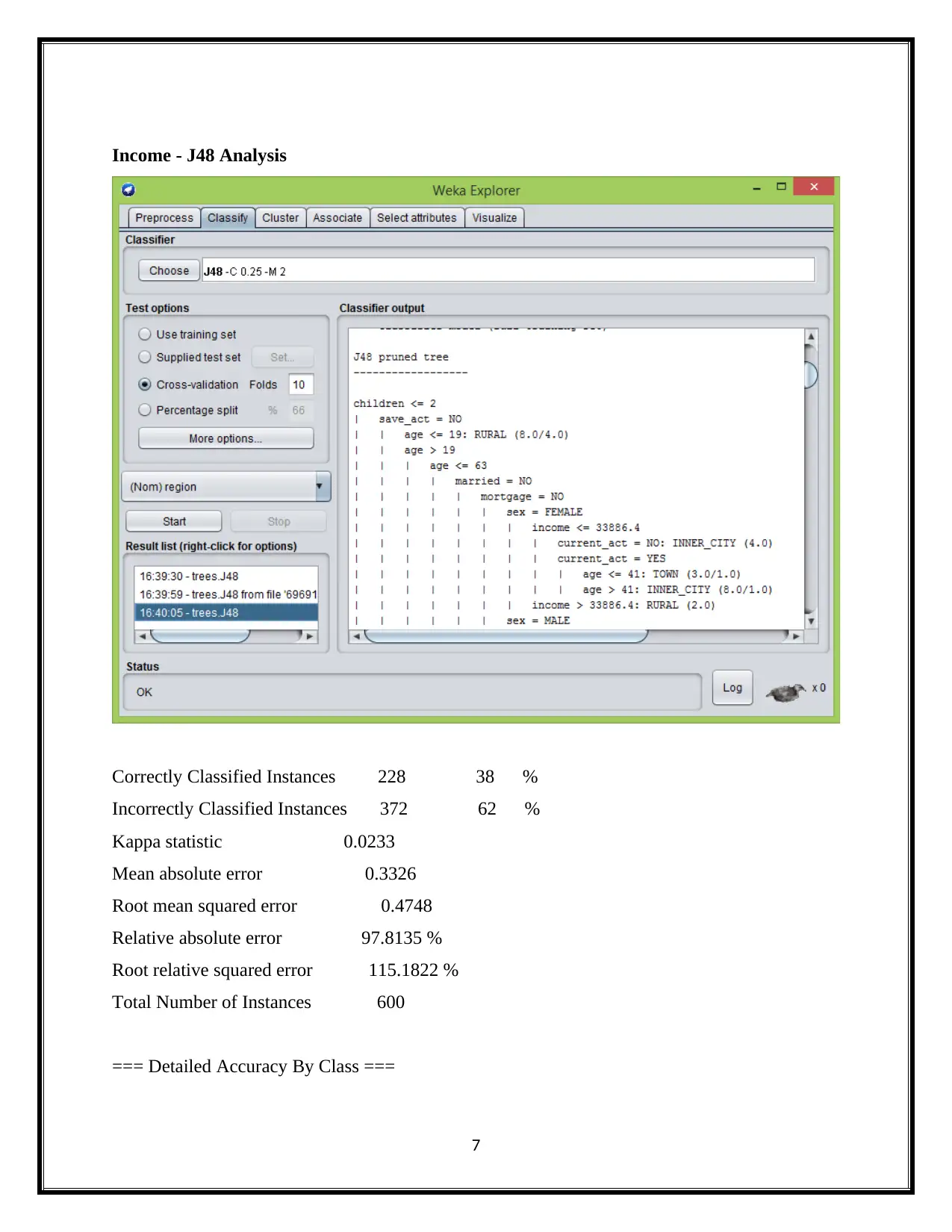
Income - J48 Analysis
Correctly Classified Instances 228 38 %
Incorrectly Classified Instances 372 62 %
Kappa statistic 0.0233
Mean absolute error 0.3326
Root mean squared error 0.4748
Relative absolute error 97.8135 %
Root relative squared error 115.1822 %
Total Number of Instances 600
=== Detailed Accuracy By Class ===
7
Correctly Classified Instances 228 38 %
Incorrectly Classified Instances 372 62 %
Kappa statistic 0.0233
Mean absolute error 0.3326
Root mean squared error 0.4748
Relative absolute error 97.8135 %
Root relative squared error 115.1822 %
Total Number of Instances 600
=== Detailed Accuracy By Class ===
7
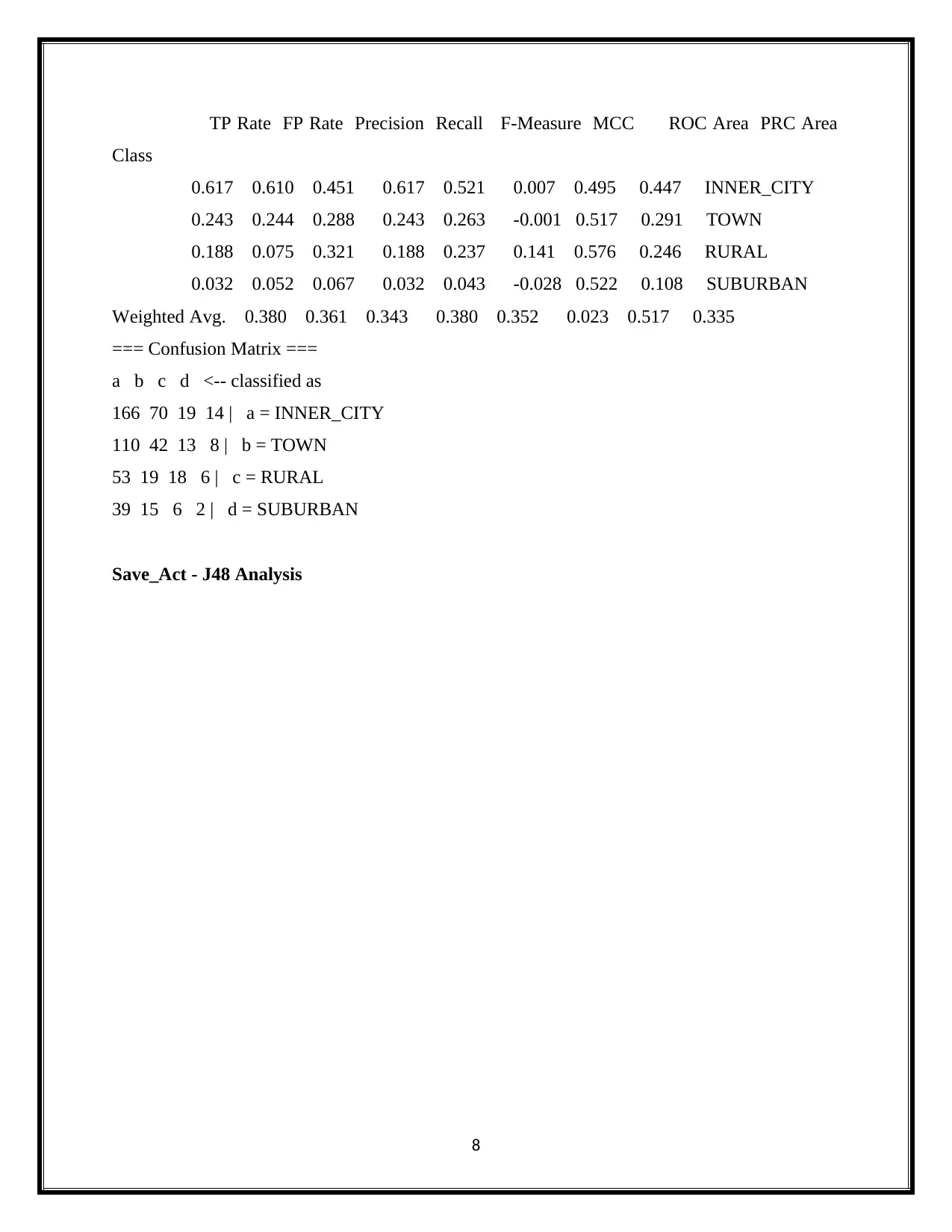
TP Rate FP Rate Precision Recall F-Measure MCC ROC Area PRC Area
Class
0.617 0.610 0.451 0.617 0.521 0.007 0.495 0.447 INNER_CITY
0.243 0.244 0.288 0.243 0.263 -0.001 0.517 0.291 TOWN
0.188 0.075 0.321 0.188 0.237 0.141 0.576 0.246 RURAL
0.032 0.052 0.067 0.032 0.043 -0.028 0.522 0.108 SUBURBAN
Weighted Avg. 0.380 0.361 0.343 0.380 0.352 0.023 0.517 0.335
=== Confusion Matrix ===
a b c d <-- classified as
166 70 19 14 | a = INNER_CITY
110 42 13 8 | b = TOWN
53 19 18 6 | c = RURAL
39 15 6 2 | d = SUBURBAN
Save_Act - J48 Analysis
8
Class
0.617 0.610 0.451 0.617 0.521 0.007 0.495 0.447 INNER_CITY
0.243 0.244 0.288 0.243 0.263 -0.001 0.517 0.291 TOWN
0.188 0.075 0.321 0.188 0.237 0.141 0.576 0.246 RURAL
0.032 0.052 0.067 0.032 0.043 -0.028 0.522 0.108 SUBURBAN
Weighted Avg. 0.380 0.361 0.343 0.380 0.352 0.023 0.517 0.335
=== Confusion Matrix ===
a b c d <-- classified as
166 70 19 14 | a = INNER_CITY
110 42 13 8 | b = TOWN
53 19 18 6 | c = RURAL
39 15 6 2 | d = SUBURBAN
Save_Act - J48 Analysis
8
⊘ This is a preview!⊘
Do you want full access?
Subscribe today to unlock all pages.

Trusted by 1+ million students worldwide
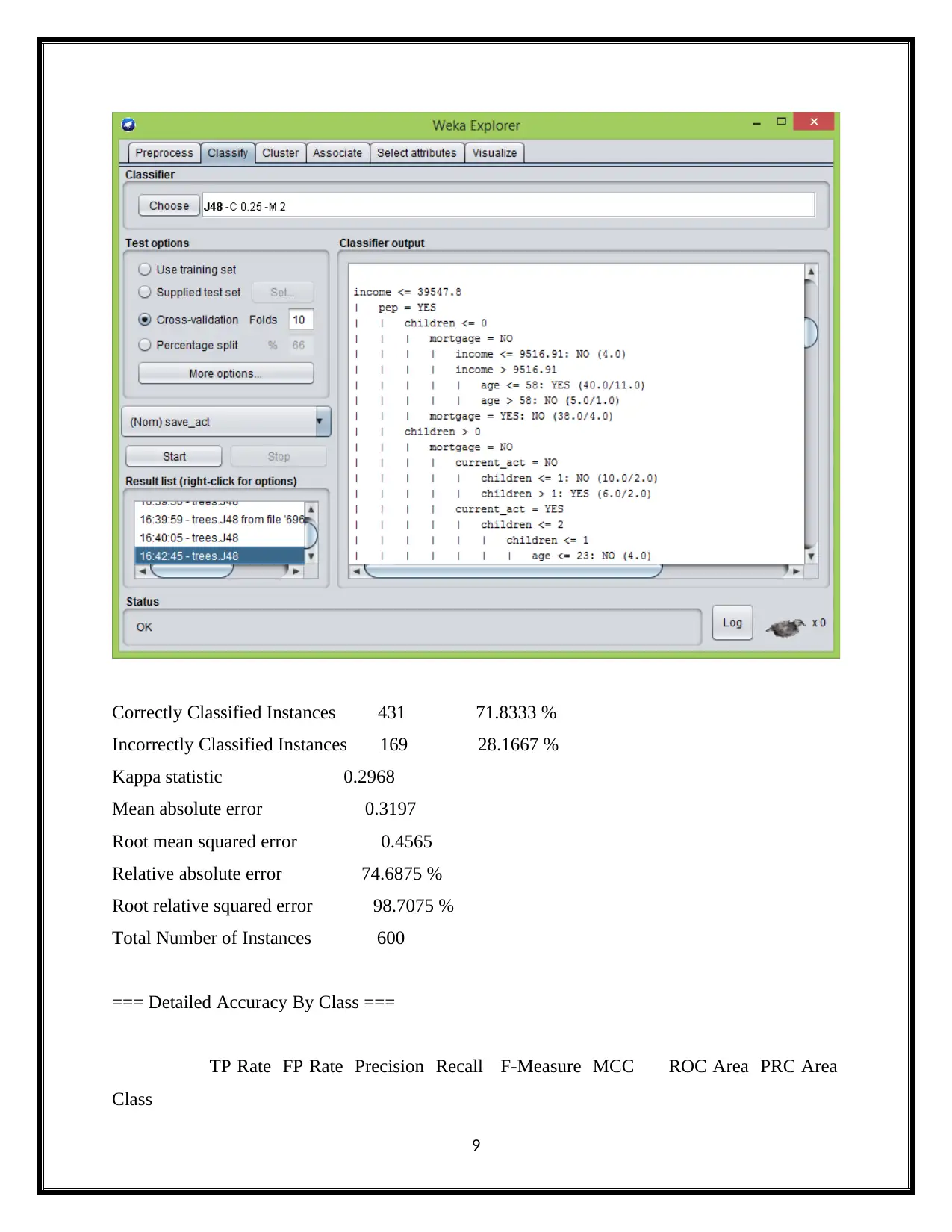
Correctly Classified Instances 431 71.8333 %
Incorrectly Classified Instances 169 28.1667 %
Kappa statistic 0.2968
Mean absolute error 0.3197
Root mean squared error 0.4565
Relative absolute error 74.6875 %
Root relative squared error 98.7075 %
Total Number of Instances 600
=== Detailed Accuracy By Class ===
TP Rate FP Rate Precision Recall F-Measure MCC ROC Area PRC Area
Class
9
Incorrectly Classified Instances 169 28.1667 %
Kappa statistic 0.2968
Mean absolute error 0.3197
Root mean squared error 0.4565
Relative absolute error 74.6875 %
Root relative squared error 98.7075 %
Total Number of Instances 600
=== Detailed Accuracy By Class ===
TP Rate FP Rate Precision Recall F-Measure MCC ROC Area PRC Area
Class
9
Paraphrase This Document
Need a fresh take? Get an instant paraphrase of this document with our AI Paraphraser
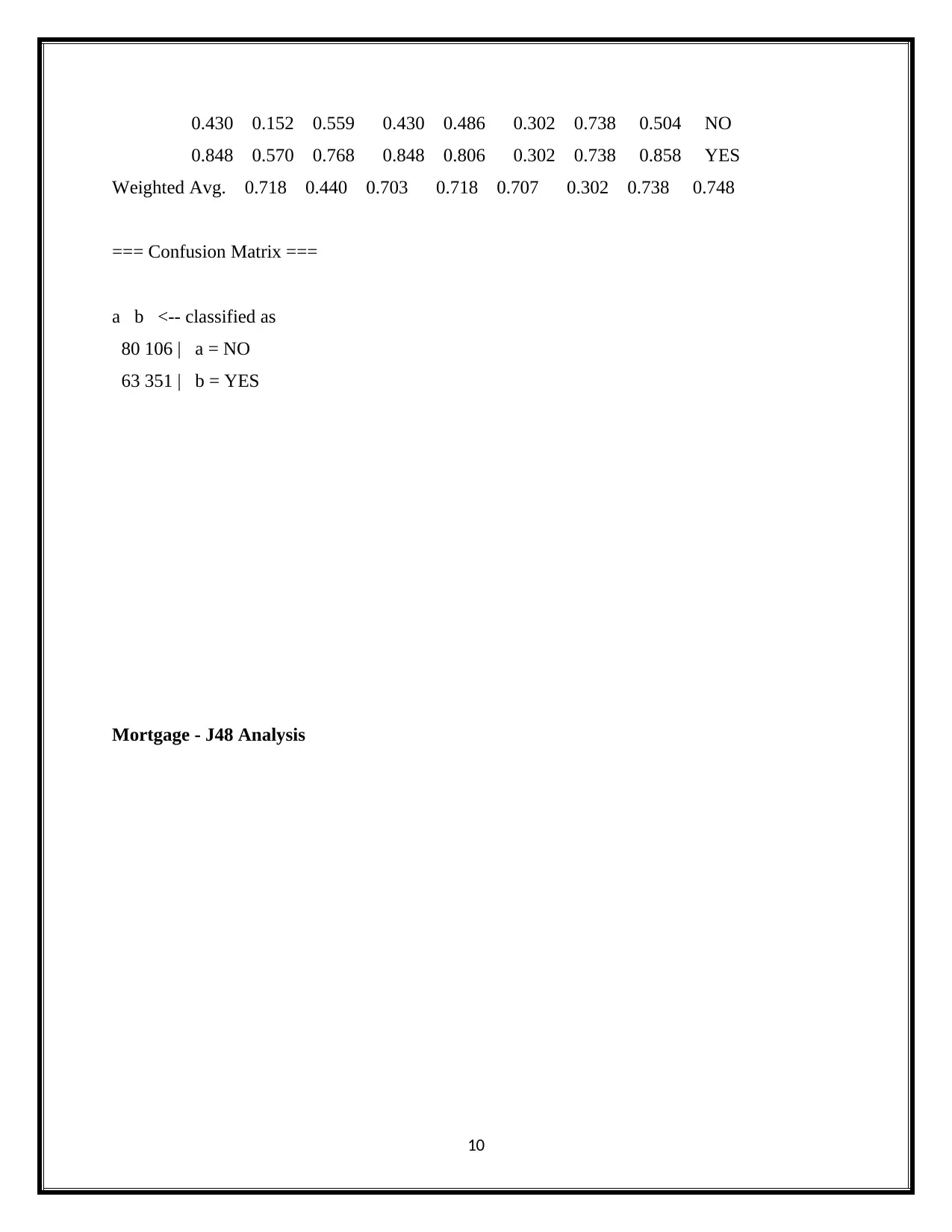
0.430 0.152 0.559 0.430 0.486 0.302 0.738 0.504 NO
0.848 0.570 0.768 0.848 0.806 0.302 0.738 0.858 YES
Weighted Avg. 0.718 0.440 0.703 0.718 0.707 0.302 0.738 0.748
=== Confusion Matrix ===
a b <-- classified as
80 106 | a = NO
63 351 | b = YES
Mortgage - J48 Analysis
10
0.848 0.570 0.768 0.848 0.806 0.302 0.738 0.858 YES
Weighted Avg. 0.718 0.440 0.703 0.718 0.707 0.302 0.738 0.748
=== Confusion Matrix ===
a b <-- classified as
80 106 | a = NO
63 351 | b = YES
Mortgage - J48 Analysis
10
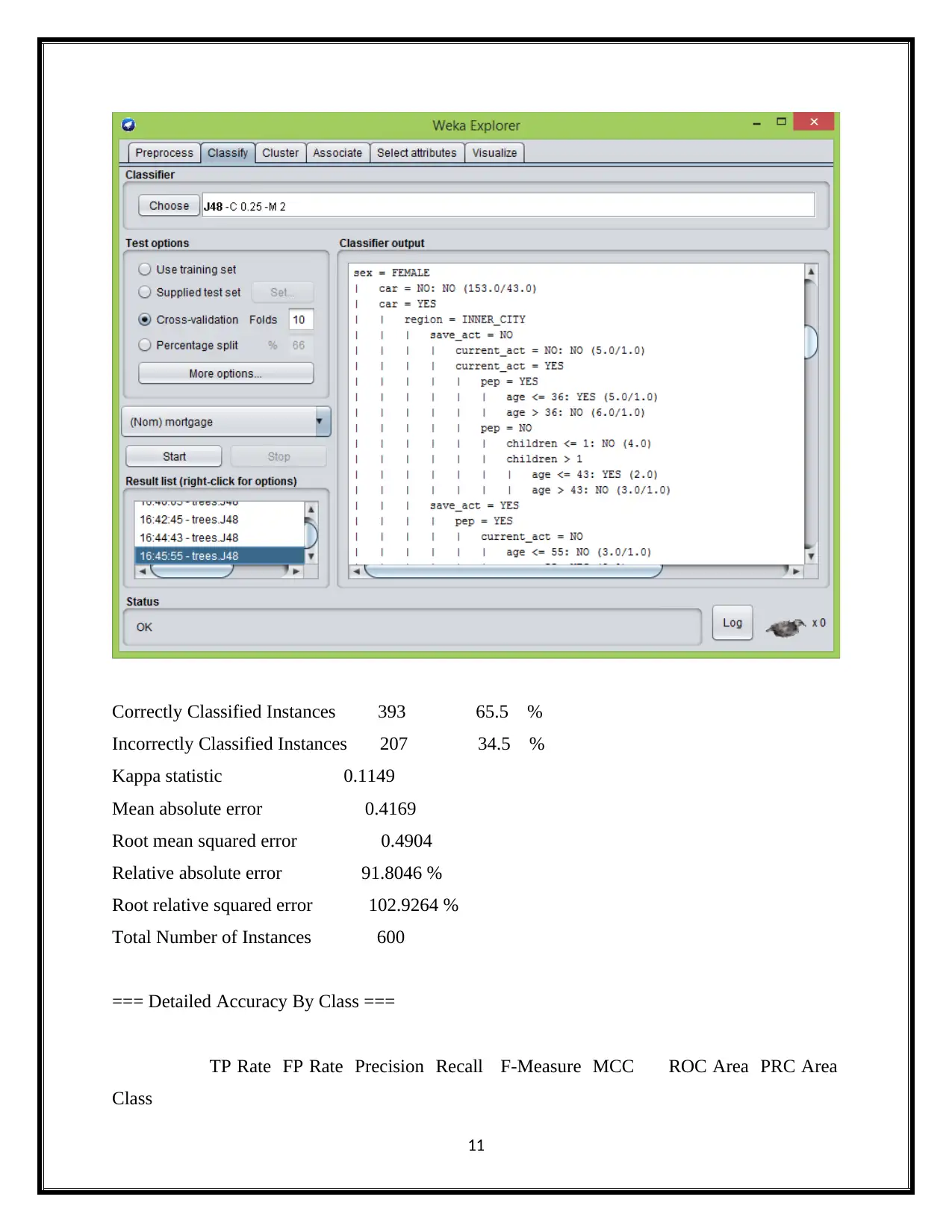
Correctly Classified Instances 393 65.5 %
Incorrectly Classified Instances 207 34.5 %
Kappa statistic 0.1149
Mean absolute error 0.4169
Root mean squared error 0.4904
Relative absolute error 91.8046 %
Root relative squared error 102.9264 %
Total Number of Instances 600
=== Detailed Accuracy By Class ===
TP Rate FP Rate Precision Recall F-Measure MCC ROC Area PRC Area
Class
11
Incorrectly Classified Instances 207 34.5 %
Kappa statistic 0.1149
Mean absolute error 0.4169
Root mean squared error 0.4904
Relative absolute error 91.8046 %
Root relative squared error 102.9264 %
Total Number of Instances 600
=== Detailed Accuracy By Class ===
TP Rate FP Rate Precision Recall F-Measure MCC ROC Area PRC Area
Class
11
⊘ This is a preview!⊘
Do you want full access?
Subscribe today to unlock all pages.

Trusted by 1+ million students worldwide
1 out of 20
Related Documents
Your All-in-One AI-Powered Toolkit for Academic Success.
+13062052269
info@desklib.com
Available 24*7 on WhatsApp / Email
![[object Object]](/_next/static/media/star-bottom.7253800d.svg)
Unlock your academic potential
Copyright © 2020–2025 A2Z Services. All Rights Reserved. Developed and managed by ZUCOL.




